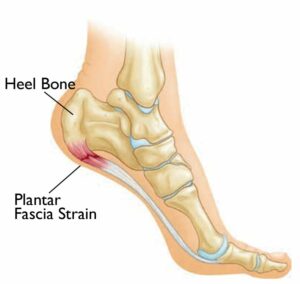
Recently I have had several clients come in with plantar fasciitis, and it’s a common reason to visit a chiropractor. In this blog we’ll explore this condition, what causes it and how I address it as a chiropractor.
What is plantar fasciitis
Plantar fasciitis is a condition that affects the sole of the foot, specifically the connective tissue called the plantar fascia. The plantar fascia is a strong band of tissue that attaches on the underside of the heel bone, and spreads out towards the front of the foot and toes. It is one of the most common causes of heel pain.
What are the symptoms of plantar fasciitis
Typically it presents as pain on the underside of the heel and in the arch of the foot. The pain can be very intense and is often worse in the morning when getting out of bed. It can be more painful after exercise.
What causes Plantar fasciitis
Plantar fasciitis develops from strain to the band of connective tissue, resulting in inflammation and pain. The Plantar fascia is designed to withstand strain and stress from walking and running. If the tissues become overloaded and over stimulated, irritation can set in and create inflammation. This can cause further stiffening of the plantar fascia, resulting in more heel and arch pain. This can set up a vicious cycle, because even short walks can aggravate the pain.
Risk Factors for plantar fasciitis
-Abnormal arch mechanics (high arch or collapsed arch)
-Tight calf muscles
-Obesity
-Changes to foot biomechanics such as ankle sprains/fractures
-Strain to the foot and calf from certain footwear
-Repetitive impact sports like running
– Ocupations that involve a lot of time on your feet
-Changes to posture that cause leg tension (read more here)
What is the chiropractic treatment approach to plantar fasciitis
As in every case, it is important to address the body globally as well as the local area of pain. This ensures you get a long lasting resolution and not just short term pain relief.
Local treatment: Typically we find with plantar fasciitis that the arch is ‘dropped’ and the motion in the heel bone is severely restricted. If the heel is not moving properly, the foot is unable to dissipate pressure and tension through the planar fascia. Every time we take a step the foot should have enough flexibility in the arches to absorb the forces. With a ‘flat’ arch and restricted heel motion, the foot isn’t able to cope with these forces, leading to irritation and strain in the tissues, including the calf muscle.
Global Holistic treatment: as mentioned above, we’d typically see tightness in the calf and achilles tendon on the side of the plantar fasciitis. This pattern of tension ‘locks’ the heel bone and reduces the mobility in the hind foot, predisposing you to plantar fasciitis. This heel tension and calf tightness normally develops from a misaligned pelvis. If the pelvis is restricted in movement on one side, this very often winds up the muscles down the back of the leg, including the calf muscle. What we see upon correcting the pelvic balance is immediate relaxation and lengthening of the calf muscle, allowing the heel to free up and move better.
Do you recommend insoles or orthotics
In most cases we don’t recommend insoles, because the foot is designed to function perfectly as it is, it simply needs to be able to move in the right way. It is far better to correct the foot imbalance directly rather than rely on something external, because this is not actually correcting the problem. In certain circumstances where a person has severe collapsed arches and flat feet, insoles can be beneficial.
Conclusions
Reducing the tension and strain on the plantar fascia is the goal of the chiropractor. By addressing blockages in the arch of the foot and local restrictions involving the heel bone, we can free up the tension and get the foot functioning and moving optimally. From there we address the pelvic imbalance that creates tension down the back of the leg and calf. Once the proper motion is restored, the foot will free up and be capable of dissipating the forces through the foot, allowing the plantar fascia to come out of the inflamed state and heal.
Get in touch for more information or to make an appointment today!
Image. OrthoInfo. Plantar Fasciitis and Bone Spurs. https://orthoinfo.aaos.org/en/diseases–conditions/plantar-fasciitis-and-bone-spurs [accessed 25/06/22]
